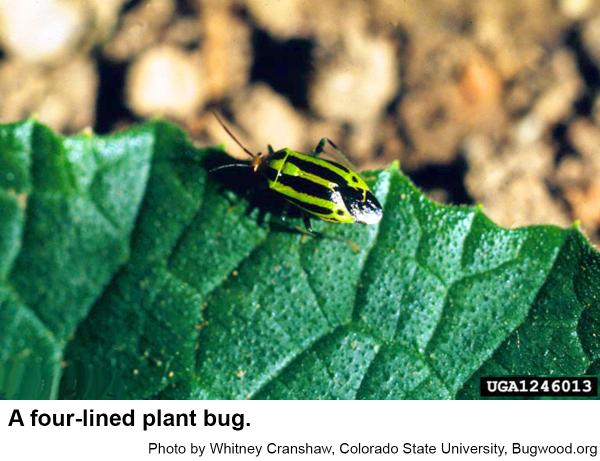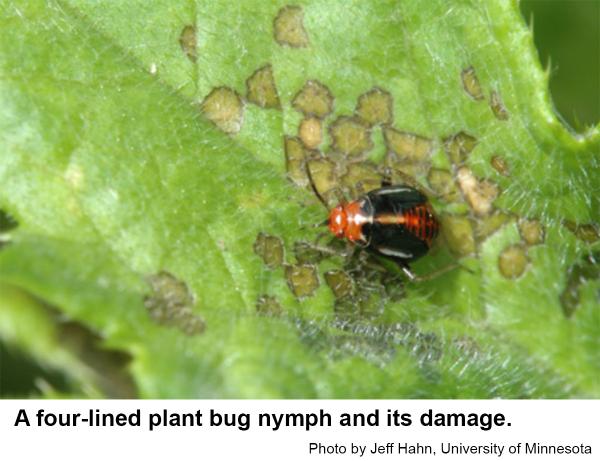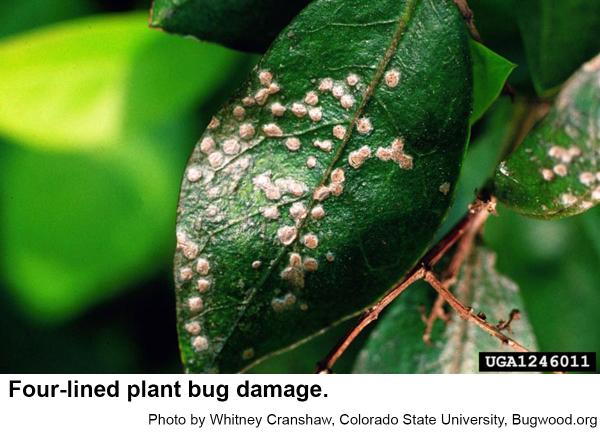Description and Biology
Fourlined plant bugs, Poecilocapus lineatus, are easily identified by the four black stripes running down the back on a yellow or greenish yellow background. They are about 1/4 inch long. The antennae and body are black, and the legs are yellow-green with black marks. Adults are active and fly readily when disturbed, and nymphs drop down when disturbed. Nymphs are red to orange with black dots on the abdomen. Older nymphs have black wing pads each with a yellow stripe. During the fall, the banana-shaped eggs are laid in individually in groups of six or more vertical slits two to three inches long on plant stems. Eggs overwinter and hatch as plant resume growth the following spring. Nymphs remain near their hatching site and feed on the upper side of leaves, injecting saliva and removing predigested plant juice. Nymphs develop and grow through five molts in three to six weeks. At the last molt, fourlined plant bugs emerge as adults. Adults feed about a month before mating. We have one generation per year in North Carolina.
Host Plants
Fourlined plant bugs feed on over 250 fruits, many garden vegetables, and herbaceous plants such as chrysanthemum, dahlia, delphinium, lupine, peony, phlox, snapdragon, daisy, mint, sunflower, and zinnia. The damage looks similar to fungal disease spots and can be misidentified as such. With needle-like mouthparts, the fourlined plant bug injects a toxin that digests the components responsible for holding the plant cells together. The bug then sucks out the predigested soup resulting in white, dark, or translucent spots 1/16 to 1/8 in. in diameter. Spots may eventually merge together into large blotches. Entire leaves can turn brown, curl up and eventually fall off. Feeding on new growth may cause wilting. Damage is usually not severe enough to cause plant death although smaller plants are more likely to be stunted.
Residential Recommendations
Insecticidal soaps and horticultural oils are recommended to control fourlined plant bugs. Most of the insecticides labeled for home use on landscape ornamentals should give more than adequate control as well. Fourlined plant bugs are an occasional pest in North Carolina, and may show up any time during the growing season. A few bugs can cause severe cosmetic damage so it is a good idea to examine flowers and shrubs regularly for this pest (and others!).
References
- Common name: fourlined plant bug, scientific name: Poecilocapsus lineatus (Fabricius) (Insecta: Hemiptera: Miridae). Borden, M. and A. Dale. 2016. Featured Creatures, Entomology & Nematology, FDACS/DPI, EDIS. Publication Number: EENY-669
- Four-Lined Plant Bug. Genetzky, A., E. C. Burkness and W. D. Hutchison. 2013. VegEdge, Vegetable IPM Resource for the Midwest. Department of Entomology, University of Minnesota.
- Fourlined plant bug in home gardens. Hahn, J. and S. Wold-Burkness. 2018 (reviewed). University of Minnesota Extension.
- Fourlined Plant Bug, Poecilocapsus lineatus (Fabricius); Family: Miridae. Klass, C. 2012 (update). Insect Diagnostic Lab. Cornell University, Dept. of Entomology.
- Extension Plant Pathology Publications and Factsheets
- Horticultural Science Publications
- North Carolina Agricultural Chemicals Manual
For assistance with a specific problem, contact your local N.C. Cooperative Extension Center.
This Factsheet has not been peer reviewed.
Publication date: June 9, 2016
Reviewed/Revised: Sept. 17, 2019
Recommendations for the use of agricultural chemicals are included in this publication as a convenience to the reader. The use of brand names and any mention or listing of commercial products or services in this publication does not imply endorsement by NC State University or N.C. A&T State University nor discrimination against similar products or services not mentioned. Individuals who use agricultural chemicals are responsible for ensuring that the intended use complies with current regulations and conforms to the product label. Be sure to obtain current information about usage regulations and examine a current product label before applying any chemical. For assistance, contact your local N.C. Cooperative Extension county center.
N.C. Cooperative Extension prohibits discrimination and harassment regardless of age, color, disability, family and marital status, gender identity, national origin, political beliefs, race, religion, sex (including pregnancy), sexual orientation and veteran status.



